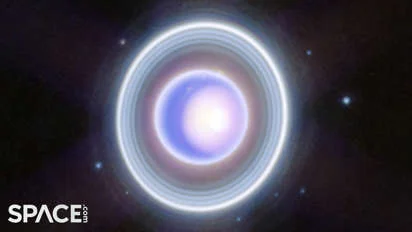
NASA’s Infrared Telescope Facility Achieves Unprecedented View of Uranus’ Interior Through Rare Stellar Occultation
In an astronomical coup, NASA scientists have achieved an unprecedented view of Uranus' interior thanks to a rare stellar occultation event observed last April. This celestial alignment, where Uranus passed directly between Earth and a distant star, provided a unique opportunity to probe the ice giant's atmosphere and rings in ways not possible for decades. Why is this important? Because it's giving us insights into a planet we haven't studied closely since Voyager 2's flyby in 1986, paving the way for future missions and a better understanding of our solar system.
What exactly is a stellar occultation? Imagine a mini-eclipse, but instead of the moon blocking the sun, it’s a planet blocking a distant star. As William Saunders, planetary scientist at NASA’s Langley Research Center, explained, as Uranus occulted the star, its atmosphere refracted the starlight, causing it to gradually dim. This created a “light curve,” a detailed record of how the starlight changed, allowing scientists to measure the temperature, pressure, and density of Uranus’ atmosphere at different altitudes.
The April 7 event, visible from parts of western North America, brought together an international team of over 30 astronomers using 18 professional observatories. This level of collaboration was unprecedented for an occultation. Even NASA’s Infrared Telescope Facility (IRTF) on Mauna Kea, Hawaii, joined the effort. Emma Dahl, a postdoctoral scholar at Caltech, noted the importance of such events for studying the atmospheres of gas and ice giants, as they lack solid surfaces that can complicate observations.

To prepare for this significant event, NASA Langley researchers conducted a “test run” in November 2024. By coordinating telescopes in Japan and Thailand, they calibrated their instruments and refined the predictions of Uranus’ location with remarkable precision. This preparation proved critical for successfully observing the April occultation.
What did they learn? The data gathered isn't just about refining measurements of Uranus’ atmosphere. Scientists are also using it to study the dynamics of its rings, measure atmospheric turbulence, and improve the precision of Uranus’ orbit. By comparing this new data with past observations, they hope to determine if Uranus’ climate has changed over the last few decades.
Looking ahead, NASA is already planning for the next bright Uranus occultation in 2031. This event promises to provide even more detailed insights into this mysterious ice giant.
The recent stellar occultation of Uranus represents a major step forward in our understanding of this distant world. This collaborative effort highlights the power of international cooperation in advancing scientific discovery. What other secrets will Uranus reveal in the coming years? Leave a comment below and share your thoughts!